Showing posts from category: Architecture Practice

In a recent article by the New York Post titled “NYC Landlords Luring Workers to Offices with Fancy Perks,” https://nypost.com/2024/03/20/real-estate/nyc-landlords-luring-workers-to-offices-with-fancy-perks/ the spotlight shines on the enticing perks offered by landlords to attract employees back to the office amidst shifting work dynamics. While these perks may seem appealing for large corporations, the landscape for small businesses, particularly architecture and design firms with fewer than 50 employees, presents different challenges and considerations.
The allure of onsite amenities such as fitness centers, gourmet cafeterias, and communal spaces undoubtedly holds sway for many professionals. However, for smaller firms nestled within NYC’s vibrant architecture and design scene, the feasibility and practicality of such offerings may vary significantly.
In this blog post, we delve into the nuances of office perks through the lens of small architecture and design firms. While acknowledging the allure of these amenities, we explore why the strategies highlighted in the article might not seamlessly translate to the realities faced by smaller businesses.
As advocates for the growth and sustainability of small firms, we’ll examine:
1. Budget Constraints: The financial implications of implementing extravagant perks for firms operating within tighter budgets.
2. Cultural Dynamics: How small firms’ unique culture and ethos influence the appeal and relevance of office perks.
3. Practical Solutions: Alternative strategies tailored to the needs and aspirations of small architecture and design firms, fostering employee engagement and retention without breaking the bank.
By critically analyzing the insights from the article within the context of small business operations, I aim to equip our readers with practical perspectives and actionable strategies to navigate the evolving landscape of workplace amenities. Join us as we unravel the intricacies of office perks and chart a course tailored to the distinct needs of small architecture and design firms in the vibrant ecosystem of NYC.
Small architecture and design firms must carefully consider every expenditure to ensure optimal resource allocation. While the lavish perks mentioned in the article may foster a desirable work environment, they often come with a hefty price tag, directly and in a building that includes these amenities in the rent. Small firms, particularly those in the startup phase or experiencing rapid growth, may need help to justify such expenses. Instead, prioritizing investments in essential resources like cutting-edge design software, professional development opportunities, or collaborative workspaces tailored to the specific needs of architects and designers can yield more tangible benefits within a constrained budget.
The culture of a small architecture or design firm often thrives on intimacy, collaboration, and a shared passion for creativity. Unlike large corporations, where employees may be drawn to onsite amenities as a substitute for a sense of community, small firms typically foster a familial atmosphere where personal connections and shared values reign supreme. As such, the allure of extravagant perks may pale compared to the intrinsic rewards of working closely with like-minded colleagues on stimulating projects that align with one’s design philosophy. Cultivating this unique culture becomes a cornerstone of employee satisfaction and retention, superseding the need for flashy office amenities.
While acknowledging the appeal of office perks, small architecture, and design firms can adopt more pragmatic approaches to enhance the workplace experience for their employees. Emphasizing flexibility in work arrangements, providing opportunities for professional growth and mentorship, and fostering a collaborative work environment where employees feel valued and empowered can significantly impact job satisfaction and retention. Investing in wellness programs, such as yoga classes, mindfulness sessions, or ergonomic workstations, can promote employee well-being without straining the budget. By aligning perks with the values and aspirations of their workforce, small firms can cultivate a vibrant workplace culture that sets them apart in a competitive market.
In conclusion, while the allure of fancy office perks may capture headlines, the reality for small architecture and design firms in NYC paints a different picture. Budget constraints, cultural dynamics, and the need for practical solutions tailored to the unique needs of small businesses necessitate a nuanced approach to enhancing the workplace experience. Small firms can create environments where employees thrive and excel by prioritizing investments that align with their values, fostering community and belonging, and embracing flexibility and innovation. As the work landscape continues to evolve, small architecture and design firms stand poised to lead the way in redefining what constitutes a fulfilling and enriching workplace experience in the dynamic metropolis of New York City.
#ArchitectureNYC #DesignFirms #SmallBusinessNYC #OfficePerks #WorkplaceCulture #SmallFirmSolutions #BudgetFriendlyPerks #EmployeeEngagement #WorkplaceWellness #CreativeWorkspaces #NYCDesignScene #InteriorDesigners #ArchitectsLife #OfficeAmenities #SmallBizTips #StartupStrategy #DesignPhilosophy #TeamCollaboration #WorkLifeBalance #ProfessionalDevelopment #SmallBizCulture #EmployeeRetention #InnovativeWorkplaces #CareerGrowth #ArchitecturalTrends #DesigningSuccess #NYCBusiness #InteriorDesignIdeas #ArchitectureInspiration #SmallBizLeadership

In recent years, employees of architecture firms have increasingly attempted to join unions. This trend is driven mainly by the need for workers to protect and secure their rights as professionals. Unions provide a platform for employees to come together and negotiate fairer wages, better working conditions, and greater job security. Members can also access additional benefits such as legal advice, collective bargaining, and representation. Joining a union gives workers in the architecture field more control over their professional lives and helps to ensure that they are treated fairly and equitably by employers. As architectural firms continue to grow, the rights of employees must be protected and respected. Unions play an essential role in providing this protection, giving individuals the peace of mind that their rights and interests are protected.
By joining a union, architecture firm employees can help improve the industry. By negotiating better wages and working conditions, they can ensure that every professional in the field is treated fairly and compensated equitably for their work. The collective strength of union members also allows them to speak out against any injustices or exploitative practices they may experience, ensuring that their voices are heard and respected. With more people joining unions, the architecture industry is becoming safer and fairer for everyone involved.
Overall, union membership offers a range of benefits for employees in the architecture field. It gives them a platform to fight for their rights, negotiate better wages and working conditions, and ensure their voices are heard. By joining a union, they can help create a fairer and more equitable industry for everyone involved. As the architecture field continues to evolve, unions will remain essential to ensuring that workers’ rights are respected. But is it fools gold?
As architecture firm owners consider the implications of unionization, they must weigh the risks and rewards. Unionized firms face higher costs for labor, resulting in increased overhead that diminishes their competitive edge. Furthermore, collective bargaining agreements can restrict a firm’s ability to manage staffing levels and set salaries according to market conditions. Not being nimble can limit a firm’s ability to adapt quickly to changes in the industry, as well as its ability to attract and retain talented employees. Ultimately, these factors make unionization a less attractive option for many architecture firm owners. However, it is important to note that unions can bring tangible benefits, such as job security and improved wages and working conditions, which could appeal to some. Ultimately, it is up to individual owners to decide if unionization is the right choice for their businesses.
Architects are held to a high standard due to the critical nature of their work. They must possess excellent technical knowledge and communicate effectively with clients, designers, and contractors. As a result, they often require specialized training or certification to practice as professional architects. Despite this need for advanced skills and rigorous qualifications, architects are usually not eligible for collective bargaining, as many operate independently or in small firms and do not form unions. Thus, architects must advocate for their interests regarding workplace issues such as wages and working conditions. Architects must be aware of their rights and understand the profession’s regulations to ensure they receive fair compensation and working conditions. By doing so, architects can ensure they can continue practicing their craft in a healthy and productive environment.
Although architects traditionally do not form unions, they should still be aware of their rights and participate in the industry conversation around workplace issues. By doing so, architects can ensure they are compensated fairly and work in environments that promote their skillset and creativity. Architects must understand how their profession can benefit from unionization to better advocate for their interests.
It isn’t easy to find accurate statistics on how many architecture firms are unionized, as most are privately owned. However, there have been reports that suggest that under 3% of all architecture firms in the world and one firm in the United States may be part of a union or labor association.
Although becoming part of a union offers specific employee benefits, such as increased bargaining power and better wages, it can also be limiting in terms of flexibility. By joining a union, an architectural firm is subject to “just cause” guidelines regarding hiring and firing. Just cause means that there must be documented evidence that an employee is not meeting the standards of their position or has committed a punishable offense before they can be terminated. Therefore, it is complicated for an architectural firm to manage its workload most efficiently, as there may not be the flexibility to let go of employees quickly during times of low demand. Additionally, unions can restrict how many subcontractors or temporary workers an architecture firm can hire at any given time, limiting their ability to adapt to changing needs. Including dictating the workflow in contrast to increasing/decreasing staffing levels as needed. In addition, unions are not typically supportive of “at will” employment, which provides much more flexibility when hiring and firing.
Overall, unions can provide many benefits to architectural firms but also have certain restrictions that must be weighed carefully. Architecture firms must consider all their options before deciding on joining or not joining a union. Ultimately, the best solution will depend on each firm’s specific needs and goals.
For architecture firms that decide to join a union, there are measures they can take to ensure the best outcomes for their business. For example, firms should make sure they familiarize themselves with the rules and regulations of the union and negotiate any hiring or firing restrictions to ensure maximum flexibility when managing staff levels. Additionally, it is vital to understand the union’s grievance process and how disputes will be handled. Finally, firms should also consider creating a separate contract with the union that outlines their expectations for staffing levels and hiring and firing procedures.
By taking these measures, architectural firms can ensure that joining a union does not limit their ability to perform their work efficiently and effectively.
This information is for educational purposes and does not constitute financial, legal, or other professional advice. Please consult with a qualified professional if you require assistance.
Additional resources:
– New York Times: https://www.nytimes.com/2021/12/21/business/architects-white-collar-union.html
– The Real Deal: https://therealdeal.com/2022/09/01/new-york-firm-establishes-architectures-first-union/
– Architects’ Journal: https://www.architectsjournal.co.uk/news/do-architects-need-a-trade-union
– National Labor Relations Board (NLRB): https://www.nlrb.gov/
– American Institute of Architects (AIA): https://info.aia.org/join-aia/collective-bargaining-labor
– National Association of Architects (NAA): http://www.naahq.org/
– American Federation of Architects and Engineers: https://afae.org/
– Society of Professional & Executive Employers (SPEE): http://speeusa.org/
– U.S. Department of Labor: https://www.dol.gov/general/topic/labor-relations/labor-unions
– American Bar Association: https://www.americanbar.org/groups/labor_law/publications/aba_books/unionbargaining.html
– Harvard Law School: https://www.law.harvard.edu/news/labour/collective-bargaining-and-labor-unions/
– Cornell Law School: https://www.law.cornell.edu/wex/labor_union
– Bureau of Labor Statistics (BLS): https://www.bls.gov/opub/ted/2011/ted_20110429_data.htm
– Governing: https://www.governing.com/topics/workforce/unionizing-workers-collective-bargaining-rights.html
– National Labor Relations Board (NLRB): https://www.nlrb.gov/what-we-do/protecting-employee
Architecture Practice
|
architects, architecture, atwill, collectivebarganing, Consulting For Architects, David McFadden, design, firing, Hiring, jobs, Jobsecurity, justcause, salary, Trade, Unions, wages, workingconditions
|
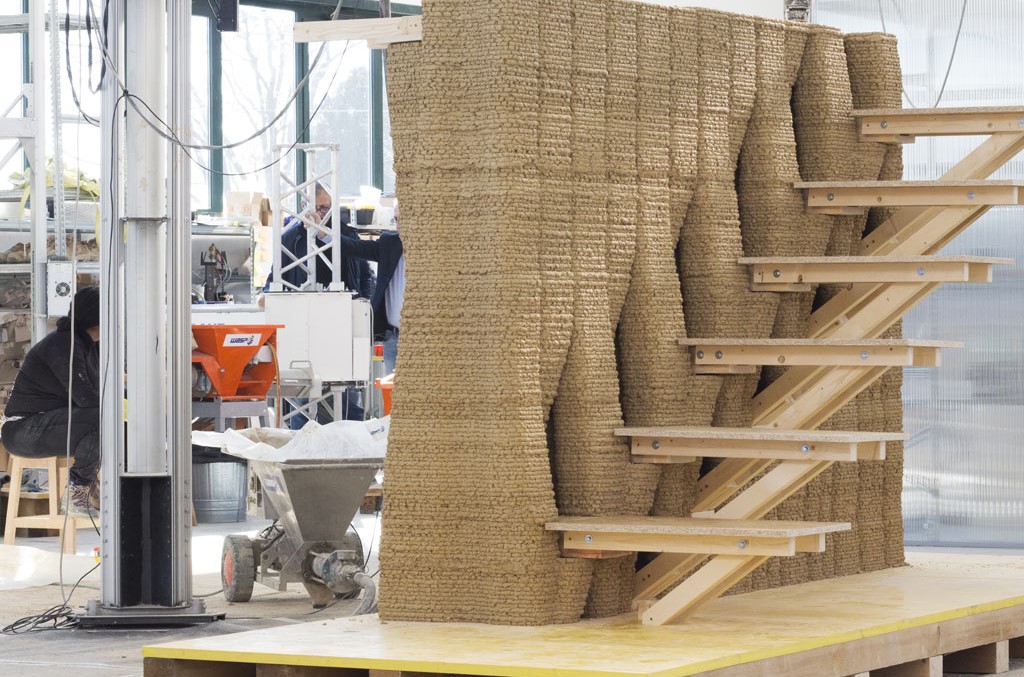
3D printing is revolutionizing the field of architecture, and it is poised to change the way we build our cities and towns in the future. Thanks to this innovative technology, we will be able to create more sustainable, resilient, and beautiful buildings than ever before.
In recent years, 3D printing has become increasingly popular, and it is now used in various industries. One area where 3D printing is making a significant impact is architecture. This technology offers several advantages for architects, including creating complex shapes and structures that would be impossible to create using traditional methods. 3D printing also allows for a high degree of customization, meaning that each architectural element can be designed to meet the project’s specific needs.
So how does 3D printing work in architecture? First, architects create a digital model of the desired structure using specialized software. Once the model is complete, it is sent to a 3D printer. The printer then creates the structure by building it up layer by layer, using materials such as plastic, metal, or concrete. This process can take anywhere from a few hours to several days, depending on the size and complexity of the project.
As anyone who has tried to put together a model kit can attest, 3D printing can be a great way to create complex shapes with high accuracy. Some of the world’s leading architecture firms are now using 3D printing to create scaled models of their proposed designs. Not only does this allow for greater precision in the planning stages, but it also allows for modifications to be made quickly and easily. In addition, using 3D printing means that architecture, engineering, and construction firms can create full-sized prototypes of their designs, which can be used to test the feasibility and identify any potential problems. As 3D printing technology advances, we will likely see more and more firms incorporating it into their design practices.
Several universities are now offering courses in 3D printing for architects. In recent years, there has been a growing interest in 3D printing among architects and other design professionals. As a result, several universities are now offering courses in this technology. These courses typically cover the basics of 3D printing, such as creating digital models and operating a 3D printer. In addition, students are often allowed to design and print their projects. These courses provide a great introduction to this exciting technology and its potential applications in architecture.
3D printing is set to change the way we build our cities. There is no doubt that 3D printing is a disruptive technology set to change how we build our cities. This technology offers several advantages for architects, including creating complex shapes and structures that would be impossible to create using traditional methods. In addition, 3D printing allows for a high degree of customization, meaning that each architectural element can be designed to meet the project’s specific needs. As the use of 3D printing technology continues to grow, we will likely see several innovative and exciting projects that push the boundaries of what is possible.
3D printing is a process that is constantly evolving and has the potential to change the landscape of architectural design. While there are some disadvantages to using this technology, the advantages often outweigh them. With continued advancement in 3D printing technology, we can only imagine what possibilities will be made available for architects and their clients. What do you think the future of 3D printing holds for architecture? Let us know in the comments below!
Related:
10 of the Best 3D Printers for Architects in 2022 Reviewed | Top Brands Compared
Reservations Begin in 2023 for the 100-home Community Codesigned by BIG-Bjarke Ingels Group
LGM turns to Quickparts for on-demand architectural modeling
Architecture Practice
|
3dmodel, 3dprinting, 3dsoftware, architects, architecture, Construction, Consulting For Architects, David McFadden, design, digital, Engineering, jobs, model, project, technology
|

Architecture Billing Index
Architecture firms anticipate relatively slow adoption rates for new and emerging technologies in design and construction
| By Kermit Baker, Hon. AIA, AIA Chief Economist |
U.S. architecture firms reported another solid month of growth in October 2015. The AIA’s Architecture Billings Index (ABI) was 53.1 for the month, demonstrating a solid increase in firm billings that was just below the 53.7 score for September. New project inquiries, with a score of 58.5 for the month, and new design contracts at 51.7, point to healthy business conditions at architecture firms. However, both readings fell a bit from their September level, suggesting that growth may moderate just a bit in the coming months.
 Click to expand The overall strong performance in business activity in recent months is beginning to show a regional pattern. Firms in the South have been reporting continued strong business conditions through the year, while firms in the West have been reporting acceleration in billings over the past few months. In contrast, Northeast firms have been reporting weak conditions in recent months, and Midwest firms—while reporting growth—have seen billings increase at a somewhat slower pace.
Firms in all the major construction sectors reported healthy conditions in October, with the strongest growth coming from commercial/industrial firms. Residential firms recorded their second straight monthly increase after seven straight monthly declines. Institutional firms saw growth on par with September, but their ABI scores have been declining for the past several months, indicating that the pace of growth of billings at these firms has been moderating.
In Spite of International Concerns, U.S. Economy Doing Well
The economy sputtered a bit in the third quarter, producing only 1.5% growth at an annualized basis. However, there appears to be some firming in economic conditions to date in the fourth quarter. There was a net increase of 271,000 payroll positions nationally in October, well above expectations, and the strongest monthly increase so far this year. That pushed the national unemployment rate down to 5.0%, its lowest level since early 2008. The construction sector has been an important contributor to the employment front, adding 31,000 payroll positions for October and 159,000 through the first ten months of the year. Construction has thus accounted for almost 8% of payroll gains so far in 2015.
An improving labor market, coupled with continued low gasoline prices, has improved the consumer’s outlook. The preliminary consumer sentiment index from the University of Michigan jumped up in November to its highest level in several months. This has produced higher levels of consumer spending, as retail sales—after netting the lower amounts spent on gasoline—saw healthy gains in October. A key test of the perceived health of the economy will come in mid-December when the Federal Reserve Board decides whether an increase in short-term interest rates is warranted to prevent potential future overheating.
Innovative Technologies May Not Yet Be Ready For Prime Time
In the design professions, as in other sectors in our economy, change is inevitable, but the pace of change may be slower than commonly thought. In an effort to see how the profession might be evolving over the coming five to ten years, this month’s question to the AIA’s Work-on-the Boards panel looked at design and construction elements that might be increasing in importance over this time period.
Topics covered included the areas of design and construction process and techniques, building characteristics, building features and systems, and construction materials. Several of the areas deemed to be becoming more widespread over this period are already fairly widely utilized, such as lighting technology systems (LED, day lighting/natural light), water conservation/efficiency, and energy efficiency designs and retrofits. The overwhelming majority of respondents felt that these design elements would be increasing in importance over the coming five to ten years.
However, other recent innovations that typically have garnered more attention may not reach the same levels of adoption over this period according to architecture firms. One example is the use of robotics in the construction process. Only one in nine respondents feels that this technology will significantly increase in importance over the next five to ten years. Conversely, about four in ten respondents feel that there were be no significant increase in this technology over the coming years. The results were not much different for 3D printing used in the construction process. Only about one in six respondents feels that this technology will significantly increase in importance in the coming years.
This month, Work-on-the-Boards participants are saying:
• After a late summer lull, clients seem to be back at their desks, making decisions and issuing RFPs and RFQs. Prospects for 2016 are looking up.
—33-person firm in the West, mixed specialization
• Firms are very busy and fees are slowly catching up with personnel salary increases.
—6-person firm in the South, institutional specialization
• Northeast (other than NYC) is still struggling to come out of the recession.
—4-person firm in the Northeast, mixed specialization
• New problem for us, long-predicted: talent shortage. Could increase staff by 15-20% if people were available. I expect this to last a long time.
—20-person firm in the Midwest, commercial/industrial specialization
Additional Resources:
Join the AIA Practice Management Knowledge Community to receive more practice-related content
Reference:
The ABI Work-on-the-Boards Survey Panel is open to any AIA member who is principal/partner of their firm. Apply to join the ABI panel by completing a brief background information form on your firm here.
Article originally posted on the AIA.org Website. |
Architecture Practice
|
aia, architects, architecture, Architecture Billing Index, Consulting For Architects, David McFadden, design, Economics, Federal Reserve, Fees, Inc, Labor Market, Salaries, Talent Shortage
|
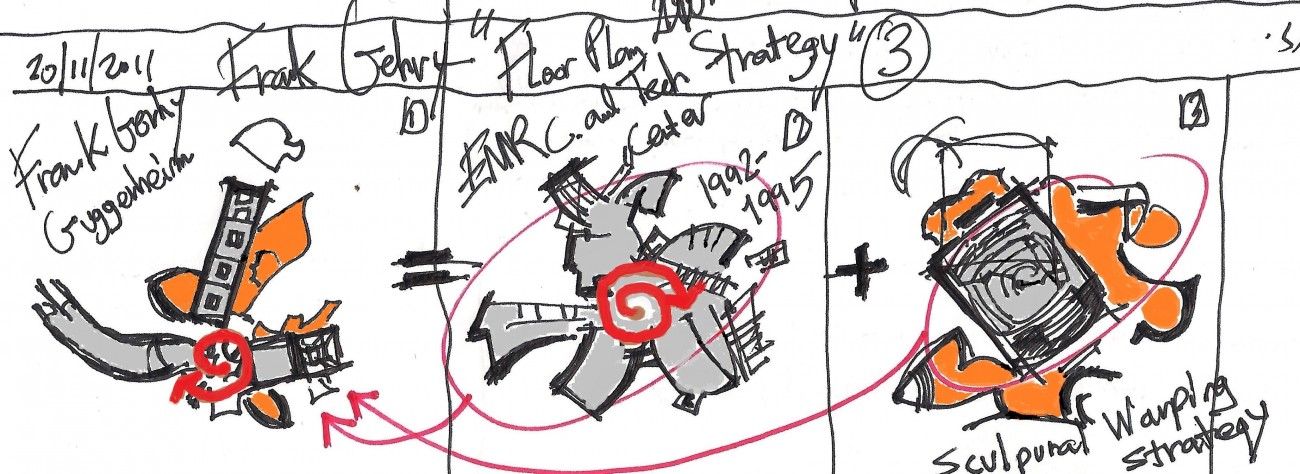
Featuring the hand sketches of Frank Gehry provides an inside look into Mr. Gehry’s architecture. “I know I draw without taking my pen off the page. I just keep going, and that my drawings I think of them as scribbles. I don’t think they mean anything to anybody except to me, and then at the end of the day, the end of the project they wheel out these little drawings and they’re damn close to what the finished building is and it’s the drawing.” Frank Gehry, FAIA. Because Mr. Gehry’s sketches are original and unique, we thought it fitting to launch our CFAeX Autodesk AutoCAD, Revit, and BIM Certification Exams home page is showcasing his work. The CFAeX.com website has compiled a slideshow for you. View the slide show.


Lingering impact from the Great Recession slows gains in salaries
Over the last several years, most architecture firms have benefited from a general improvement in the economy as well as in the construction sector. Revenue at architecture firms increased almost 11 percent in 2012 from 2011 levels, according to U.S. Census Bureau figures, and firm payrolls have followed suit. But this modest improvement in business conditions has done little to lift compensation levels at firms. Between 2011 and 2013, average total compensation for architecture positions—including base salary, overtime, bonuses, and incentive compensation—increased only slightly over 1 percent per year, barely more than the average increase in compensation between 2008 and 2011, when the construction sector was still in steep decline.
Even this modest 1 percent increase in average architect compensation may overstate the experience of the typical architect during this period. Average compensation depends on the mix, by experience levels, of positions reporting. Since many less experienced architecture positions were eliminated during the downturn, current average compensation may reflect a higher share of more experienced (and more highly compensated) positions. Regardless, while average compensation for architecture positions increased a mere 0.7 percent per year compounded between 2008 and 2011, growth increased to only 1.1 percent per year between 2011 and 2013 (Exhibit 1.1).
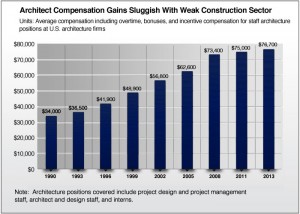
Architecture staff compensation tends to be more volatile over the business cycle than compensation for most other occupations. Over the past decade, compensation gains for architecture positions have more than kept pace with compensation across the entire economy. Architecture compensation increased 35 percent between early 2002 and early 2013, compared to just under 32 percent for all professional and related staff (typically defined as white-collar workers such as lawyers, accountants, etc.), and just over 29 percent for all private-sector workers (Exhibit 1.2).
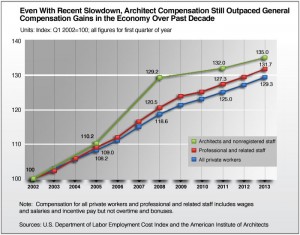
Compensation levels vary by firm size
Historically, large architecture firms have offered higher levels of compensation. These comparisons are more difficult for more senior positions because job responsibilities are difficult to compare across firms of different sizes. However, this disparity exists even for positions with relatively standard job descriptions such as Intern 1 or Architect 1.
At firms with fewer than 10 employees, Intern 1 compensation averaged 10 to 15 percent below national averages. At firms with more than 250 employees, Intern 1 compensation averaged more than 10 percent above the national average. A similar pattern held for Architect 1 positions: about 10 percent below the national average at firms with fewer than 10 employees, and almost 10 percent above the national average at firms with 250 or more employees.
Staff turnover and fringe benefits reflect improvement
Another sign that business conditions have stabilized across the profession is that benefits offered to employees have begun to modestly improve at many firms. While declining between 2008 and 2011 as firm revenues eroded, they rebounded modestly by 2013, with benefits packages averaging 18 percent of base salaries for professional staff. Benefits have bounced back faster at larger firms and remain significantly higher than those offered by smaller firms (Exhibit 1.3).
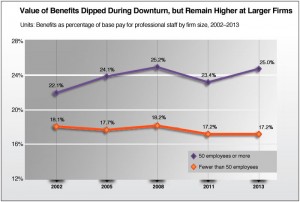
Recent Related:
AIA Compensation Survey: Architect Compensation Stagnant
Reference:
Purchase the 2013 AIA Compensation Report
New for 2013: Architect Compensation by Metro Area
Back to AIArchitect August 9, 2013
Go to the current issue of AIArchitect
Architecture Practice
|
aia, AIA NY, American Institute of Architects, architecture, Architecture billings index, Base Salaries, business, Compensation, economy, Great Recession, jobs, recession, Revenue, U.S. Census Bureau, unemployed architects
|


















